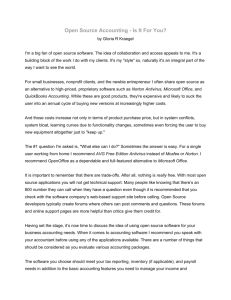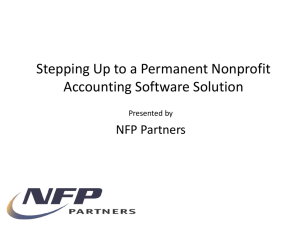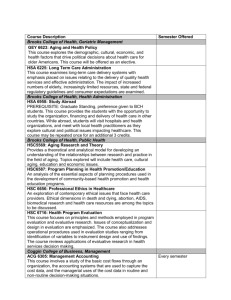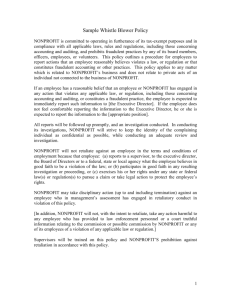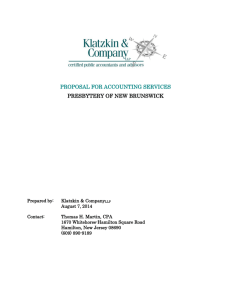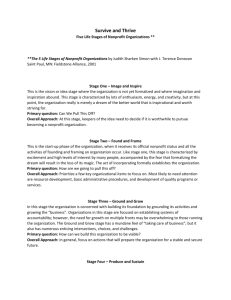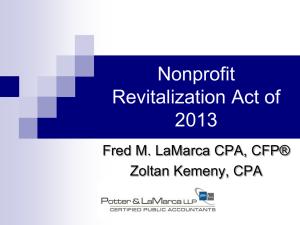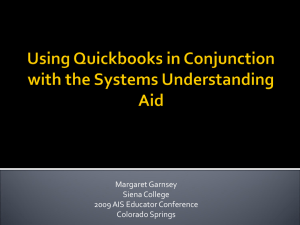Knowing When to Leave QuickBooks and Where to Go
advertisement
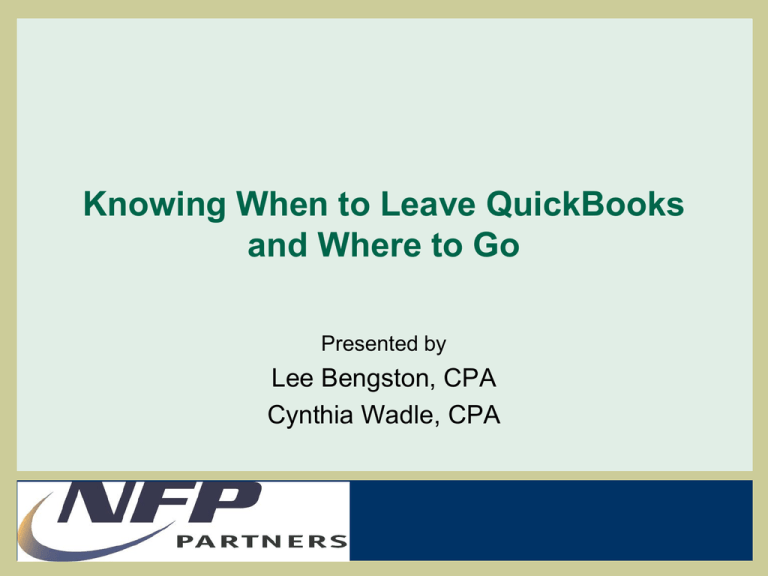
Knowing When to Leave QuickBooks and Where to Go Presented by Lee Bengston, CPA Cynthia Wadle, CPA Objective Help nonprofit decision-makers recognize that their organization is outgrowing QuickBooks, why, and know what to do about it. Agenda: Software and organizational growth Reviewing where QBs is a good fit and getting the most out of it Some leading indicators that QB is no longer up for the job Accounting requirements that are challenging to QB Alternative solutions when leaving QB Developing a transition plan Additional links and resources TYPICAL IN-HOUSE MODEL LIFE CYCLE STAGE RESOURCES STARTUP GROWTH MATURITY Principal Financial Manager Executive Director Finance Director, Controller, Business Manager (mid-level capabilities) Chief Financial Officer or Controller Finance Staff Executive Director, volunteer, relative Accounting clerk or bookkeeper, often main financial manager Specialized accounting staff Accounting System Excel, entry-level software (QuickBooks or like) Entry-level software with a growing awareness of better tools Mid-level software with nonprofit focus Board financial expert None One person with some financial skills 2-3 qualified financial professionals When is QuickBooks a Good Solution for Nonprofits Financial management best practices in place Management values financial information and understands risks. There is a qualified accounting person on-staff or available. Accounting member is part of the management team. There is a qualified Board member or other resource to provide oversight of the accounting function. An early- to mid-growth organization Annual operating budget not too much over $2M A single main organizational entity No more than a 2 or 3 main funding sources Most funding is program generated or from unrestricted contributions Best Practices for QB’s Use in Nonprofit Organizations The basic account structure and use GL account – the what? (assets, liabilities, net assets, revenue, expenditures) Class – the purpose or why? (programs, fund raising, administration, restrictions) Form 990 categories Restrictions Board designations Job – available to track projects, grants, contracts, special events, etc. Best Practices for QB’s Use in Nonprofit Orgs (cont) Use numbered accounts and class codes. Sub-accounts and sub-classes not more than two levels Prompt to assign classes. Code transactions at lowest account and class levels. Periodically review coding structures, use tools to revise and reorganize. Have a 2nd knowledgeable person review financial statements. Setup customer and job types for report filtering. Memorize key recurring reports and assign to report sets. Export report sets to consistently named Excel workbooks. Reconcile donor software reports to pledges receivable and cash Accountant’s edition and statement writer Some leading indicators that QB is no longer up for the job 3 or more concurrent users Fairly frequent slowdowns and freeze-ups Multiple grants with different fiscal reporting periods and rules Direct or indirect federal funding over $500k (OMB Circular A133 audit) Manual interfaces with other systems Distribution of labor and other costs to grants and programs burdensome Need for indirect cost allocation Budget inflexibility Financial analysis all off-line Some leading indicators that QB is no longer up for the job (cont) Over-use of Excel for subsidiary records Excel reporting more time-consuming and error-prone Audit preparation and coordination are a big extra workload Restricted funds growth Fund accounting required or advisable Need to track revenue/expenditures and budgets to multiple objects (departments, locations, projects, etc.) Chart of accounts bastardized beyond repair Internal control and security issues Audit trail issues More and more workarounds Pressure from outside auditors and funders Accounting requirements that challenge QB Tracking beyond GL/Class/Job Direct cost allocation (splits) No indirect cost allocation capability Grant budgeting and tracking for cross-FY reporting User access security limited No multiple budgets and forecasts No built-in budget control tools GAAP for nonprofit (FASB 117) and gov’t (GASB 34) not supported No fund accounting Reporting scope and flexibility Alternative accounting solutions when leaving QB Commercial ERP systems Sage MAS or Pro, MS Dynamics GP, others Netsuite or Intacct Specialized nonprofit accounting systems Sage Fund Accounting Financial Edge (Blackbaud) Serenic Navigator AccuFund, Traverse, Fund E-Z , Cougar Mountain, CenterPoint In-house or hosted Client-server or web-based Developing a transition plan Get realistic; adjust attitude on price; usually dealing with organizational transition Be prepared to justify the investment to board and get it in the budget: Staff time spent on extra work outside the system that could be saved and re-deployed Compliance with GAAP and following best practices Opportunity cost of missed revenue opportunities Audit and internal control issues Risk of fraud or misallocation of assets Frame in an organizational growth context Value of better strategic decisions based on better information Developing a transition plan (cont) Evaluate needs – what are the 3-4 main issues to solve Consider organization and personnel Appoint lead person for project Frame acceptable alternatives In-house Hosted Web-based Client-server Outsourced or hybrid Find potential providers (Web, peers, published reviews) Hold preliminary conversations with vendor or VARs Developing a transition plan (cont) Attend overview demos Get preliminary pricing Ask for references of similar organizations Narrow the field to one or two potential solution sources Share time and information with providers Have software demonstrated to address main issues Select provider Finalize agreement Develop implementation plan



